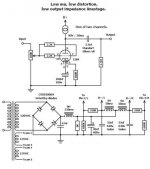I have a pair of charlize-2 amp baords from diy paradise. They will be running my speakers bi-amped.I would like to build a simple tube preamp to drive the amps. I dont think i need much gain at all so i'm just trying to add a bit of tube goodness to the sound. I would like something fairly straight forward and not too hard on the wallet.
Thanks
Thanks
Low gain and good sound sure seems like 12B4 territory to me. There are any number of decent designs available. Of course, I'm uploading the version I'm associated with. 
Make the net I/P impedance presented by the "sand" amps 15 KOhms, to hold gain down.
Make the net I/P impedance presented by the "sand" amps 15 KOhms, to hold gain down.
Attachments
IIRC, Allied sells directly in Canada. A Triad VPL24-400 (Allied stock # 70218209) takes care of providing 2X suitable "12" VAC heater windings. A Triad N-68X isolation trafo (Allied stock # 70218526) takes care of B+. Those 2 combined cost about 20 USD.  Canada's own Hammond makes suitable filter chokes. A pair of Hammond 155Hs takes care of the 5 H. parts. A Hammond 193J will take care of the 1st inductor position. Use a 10 KOhm bleeder rated for at least 5 W.
Canada's own Hammond makes suitable filter chokes. A pair of Hammond 155Hs takes care of the 5 H. parts. A Hammond 193J will take care of the 1st inductor position. Use a 10 KOhm bleeder rated for at least 5 W.
A 2nd generation of high PIV SiC Schottky diodes has become available. The pricing of those parts is more favorable. Use 4X 2 A. rated 600 PIV parts in the bridge rectifier.
Use 4X 2 A. rated 600 PIV parts in the bridge rectifier.
The rail voltage that pseudo choke I/P filter produces has to be set at the bench, with the bleeder installed. A 0.47 μF. cap. in the "fudge factor" position is a starting point. The capacitance in that position is adjusted until the voltage measured across the bleeder is > 125 V. and < 130 V.
The costly Mundorf O/P cap. can be quite comfortably replaced by a 4.7 μF. metalized polypropylene part, which is bypassed by a 0.47 μF. 716P "Orange Drop" film and foil part. The schematic was drawn, from a narrative I provided, by a fellow who uses the "moniker" Buzz and he LIKES "boutique" parts.
A 2nd generation of high PIV SiC Schottky diodes has become available. The pricing of those parts is more favorable.
The rail voltage that pseudo choke I/P filter produces has to be set at the bench, with the bleeder installed. A 0.47 μF. cap. in the "fudge factor" position is a starting point. The capacitance in that position is adjusted until the voltage measured across the bleeder is > 125 V. and < 130 V.
The costly Mundorf O/P cap. can be quite comfortably replaced by a 4.7 μF. metalized polypropylene part, which is bypassed by a 0.47 μF. 716P "Orange Drop" film and foil part. The schematic was drawn, from a narrative I provided, by a fellow who uses the "moniker" Buzz and he LIKES "boutique" parts.
- Status
- This old topic is closed. If you want to reopen this topic, contact a moderator using the "Report Post" button.
- Home
- Amplifiers
- Tubes / Valves
- Pls help with a preamp
